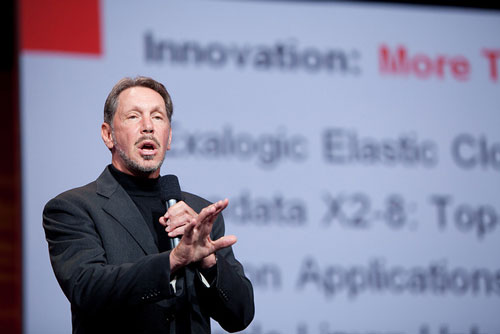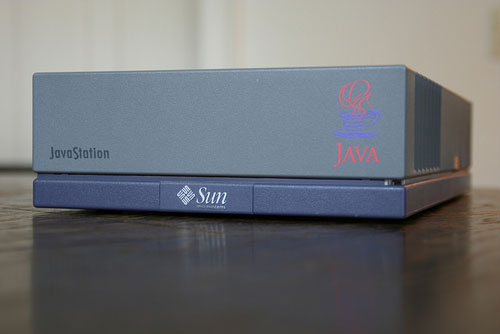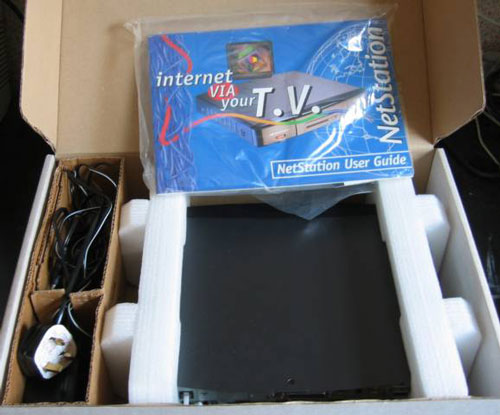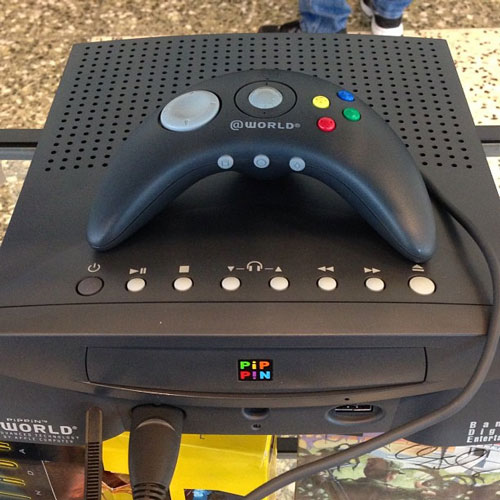The Oracle That Spoke Too Soon
Oracle CEO Larry Ellison sold the tech world on the Network Computer, a machine designed to kill the PC’s dominance. The problem? It was 15 years too early.
Today’s GIF is Ellison from “Triumph of the Nerds,” talking about how much he hates Microsoft.
Sponsored By … You?
If you find weird or unusual topics like this super-fascinating, the best way to tell us is to give us a nod on Ko-Fi. It helps ensure that we can keep this machine moving, support outside writers, and bring on the tools to support our writing. (Also it’s heartening when someone chips in.)
“The NC is clearly part of our strategy to dethrone Microsoft.”
— Larry Ellison, speaking about the Network Computer in a 1997 interview with The Independent. Ellison was a prominent, wealthy man at the time, a guy who held a lot of power in the software industry due to Oracle’s focus on relational databases—products that make the business world go round, but don’t necessarily make one a household name. Ellison also harbored what the article called a “monomania” about Bill Gates, who always seemed to get more attention for Microsoft than Ellison did for Oracle. The Network Computer, essentially a ‘90s take on the dumb terminal, was directly inspired by his battle with Microsoft.

The Network Computer’s biggest success may be in making Larry Ellison a household name
When it comes down to it, Larry Ellison’s big idea was one that failed to change the world until someone else tried the idea.
It was a far-reaching vision that reflected the thinking of someone who knew how effective databases had gotten and how sophisticated computer networks really were, but the timing of his concept was a bit off. You could argue that there were more successful historic attempts to do what Oracle was doing elsewhere; France’s Minitel comes to mind, as does the University of Illinois’ PLATO system.
But as a promotion strategy for Larry Ellison and Oracle, it was downright brilliant. This is not a knock on Ellison so much as simply stating fact—he simply did not have much of a profile outside of the world of technology before he started making the case for the Network Computer.
That idea came to prominence in direct response to the success of Microsoft, a company whose fortunes had always shone brighter in comparison to Oracle’s.
There was a clear reason for this, of course: Oracle worked higher up in the corporate food chain. Relational databases weren’t exactly something consumers directly dealt with on a regular basis, at least with their knowledge, and Oracle couldn’t exactly pull an “Intel Inside” with their product. Oracle was a vendor; by 1995, Microsoft was effectively a consumer business. No vendor would put a Weezer video on their installation CD. Microsoft Bob has a better ring to it than Oracle Bob.
The seeds of the Network Computer started in a somewhat altruistic place. Per the 2003 book Everyone Else Must Fail: The Unvarnished Truth About Oracle and Larry Ellison, an unauthorized biography about the Oracle CEO by author Karen Southwick, Ellison had the idea in 1994 while meeting with President Bill Clinton and a number of Silicon Valley CEOs, including the heads of Sun Microsystems and Apple.
He made the case that Clinton should push the computer industry to make a machine for less than $500, much as John Kennedy pushed America to go to the moon. That idea didn’t win over a lot of fans, but the cheap computer idea gained momentum within Oracle after the company wed the idea to the internet, specifically the then-new World Wide Web.
And it gained momentum outside of Oracle thanks to a well-timed media appearance on the part of Ellison. In September 1995, at the International Data Corp.’s European IT Forum in Paris, Ellison made the case for the Network Computer concept—and against the PC model, which he derided as not being a good choice for most consumers.
“A PC is a ridiculous device; the idea is so complicated and expensive,” Ellison was quoted as saying in a ComputerWorld article. “What the world really wants is to plug into a wall to get electronic power and plug in to get data.”
This was the introduction of a new vision—and Bill Gates was there to defend the old one. “You’ll still need a way of storing the applications that you download from the network and your personal data,” Gates said at the time.
Microsoft, which had just released Windows 95, had appeared to vanquish most of its enemies by this point. Apple, still without Steve Jobs, was in dire straits; IBM’s PC business was a shrinking violet in the era of clones. In Paris that week, a new challenger appeared.
Ellison’s comments pinpointed a problem with computers—they cost too much for the average person—and he had a solution. He wanted to create machines that leverage the computing resources accessible through the network, rather than requiring the user to pay up front for those resources.
By treating the computer as an appliance rather than a beefy machine in its own right, Ellison introduced a different image of the computer industry—one that gave large players on the sidelines in the Windows era, like Oracle and Sun, a way to stand out.
It was the perfect way for a guy like Larry Ellison to boost his company’s name recognition.
46M
The number of Network Computers that Oracle Senior Director Jim Lynch suggested in 1996 that there could be on the market by the year 2000, according to an estimate by CNET. (And that was the low end of his estimate—he suggested it could go as high as 100 million.) There was a lot of momentum behind the concept for a time, with Ellison’s pitch winning over firms like IBM and Netscape—firms that admittedly felt a little isolated by Microsoft’s dominance.

The Sun JavaStation, an early Network Computer built entirely around Java. (Udo Springfield/Flickr)
The Network Computer, in many ways, was warmed-over interactive television technology
In the early ’90s, a number of companies, Oracle included, tried to turn the interactive TV into a thing. It wasn’t a thing until about 1998, when a Hong Kong company launched a Netflix-like streaming service.
The public wasn’t ready for interactive TV—and that meant a lot of tech companies had innovations lying around without a context. Network Computers gave them a context.
In the case of Oracle, the buzz around interactive TV led to the creation of the Oracle Media Server, which was intended to deliver movies, music, and other features to consumers. The parts were later used to support the NC concept.
This would become a common theme of the Network Computer, which Oracle designed the concept as something that it would not build itself but that hardware-makers would build on its behalf, much like other technologies of its time, such as the 3DO. The approach was a little loose for a standard, as it didn’t require a specific hardware platform to be used, but simply required that the platform be able to run Java applets on a diskless system at a resolution of 640x480.
This approach attracted other firms with languishing interactive television technologies. The British computing firm Acorn, for example, connected with Ellison based on an interview he did with the BBC2 show The Money Programme.
Acorn had a lot of technology lying around for a video-on-demand revolution that did not yet exist, and the company realized its set-top box technology was very similar to Ellison’s vision.
The firm, best known today for fostering the multinational semiconductor giant ARM Holdings, would rush to create a reference design to Oracle’s specifications in just a few months. Despite all that effort, Wired UK writer Tom Loosemore ultimately expressed skepticism as to whether all of Acorn’s quick work would amount to much for the firm, which lacked an international profile and seemed not to be all that passionate about the World Wide Web. (Despite Netscape being a partner in Network Computers, Acorn went with another vendor with a crappier browser, and a developer gave Loosemore a look when he dared suggest that they should have used Netscape instead.)
“The great tragedy of all this is that having set the standards and built the first serious machine, Acorn will never be a serious competitor in the market for network computers,” Loosemore wrote of Acorn’s role in the Network Computer’s creation. “As it tries gamely to flog a turkey to people who don’t yet need one, its competitors will clean up in more lucrative corporate markets where bandwidth is already available, but to which Acorn’s marketing machine has little or no access.”

The NetStation (via Chris’ Acorns)
A startup firm called NetProducts came to life in 1996 to essentially market Acorn’s design to UK consumers. The result, called the NetStation, was effectively a different take on the WebTV, which had launched in the U.S. around the same time. (That firm, which would come to be owned by Microsoft, would see far more success than Ellison’s Network Computer in the home market. That must have drove Ellison crazy.)
Even some of the office-driven approaches to the network computer had roots in failed interactive television bids. Sun Microsystems, which built its Java programming language in an early bid to get on interactive TVs, eventually turned Java into a key programming language for the Web. Oracle built much of the NC spec around computers that would run Java applications, and Sun itself built a Network Computer that was Java through and through.
Even the operating system on the Sun JavaStation was written in Java, making the machine a great piece of trivia that will never come up during a game of HQ.
YouTuber Cameron Gray recently did an analysis of the system, and what he found in his archaeological dig was a bizarre little box that was slow as a dog but included a built-in office suite and Sun’s HotJava web browser. “It must be absolute hell trying to use these in a production environment,” Gray said. (It should be said that when it was released, it did not cost $500.)

The Apple Pippin. (Ivan Sosa/Flickr)
One final case-in-point on the Network Computer being warmed-over interactive TV? Apple. The company had spent much time investing in a failed console-like system called the Pippin. That machine was licensed out much like the 3DO, and the guts of that system were later applied to the NC concept.
“There will be titles designed to be Network Computer compliant, and there will be web sites that are Network Computer friendly. All these companies will have machines that can do that,” Larry Tesler, then an Apple exec, explained in a 1996 keynote. “The Pippin, or something derived from it, is one machine from Apple that will do that.”
Larry Ellison, a close friend of Steve Jobs and later an Apple board member, was often seen as an off-in-the-distance threat to Apple’s future—many Apple fans thought Ellison would try to buy the company to support the Network Computer concept. But as Ellison recalled in a 2016 commencement speech, Jobs talked him out of it, in favor of taking a more subtle approach to putting Jobs in charge of the company. That approach involved Apple acquiring his company NeXT, and Jobs slowly making the case that he should be the guy in charge once he got back in the building. Which, of course, was what happened.
That move did not favor Ellison’s idea, alas. When Jobs got back in charge of Apple, he ditched the Pippin and every other clone system Apple was supporting at the time, and released the iMac instead—a machine that’s said to have integrated some of the Pippin’s ideas.
The iMac, as it turned out, would look more the kind of machine that would end up in homes around the U.S. in 1998 and 1999—not the Network Computer.
“We believe there will be a category of networked computers in many different forms, in portable versions and desktop versions. They will exist and they will be very successful, and not just from Sun and Oracle. The price points are going to be pretty low, and they’ll look more like consumer electronics.”
— Eric Schmidt, then the chief scientist at Sun Microsystems and later Google’s CEO and Executive Chairman, discussing the value that Sun saw in the Network Computer concept in a 1995 New York Times article that questioned whether the concept would actually work. Schmidt, as Google’s chairman and CEO, would oversee a company behind the Chromebook, the closest thing we have to the Network Computer concept today.
The short view of the Network Computer—that is, the concept that Larry Ellison came up with in 1995 while Microsoft was taking over the world—was that the idea was the wrong idea for the wrong time. By late 1999, the writing was on the wall, and the warmed-over Network Computer assets were being rechristened for … wait for it … interactive television.
The clear reason for this was that Ellison’s vision of a $500 glorified dumb terminal looked like a bad bet when companies like Packard Bell were doing their best to get the price of the home computer down to a reasonable level. It didn’t help, either, that the networks of 1996 and 1997 just weren’t strong enough to support Network Computers.
Ellison did try to take another stab or two at the concept outside of Oracle, launching a machine called the New Internet Computer, or NIC, in 2000. That machine ran Linux and cost $199, rather than $500. But based on the fact you’re probably not reading this on a NIC, the idea didn’t work then, either.
But the long view was ultimately much kinder to Ellison, who it should be said is not a man who struggles for money. The Network Computer’s concepts would eventually resurface in many ways—as cloud computing, in smartphones, and at companies not owned by Larry Ellison.
Our computers tend to have a lot of storage to them, but we ultimately do a huge chunk of our work on the web. Eric Schmidt, a true believer in the concept, ultimately won big off of it at Google, messy Java lawsuit or not.
It’s not that Larry Ellison was wrong. He was just early.
:format(jpeg)/2018/04/tedium041218.gif)
/2018/04/tedium041218.gif)


/uploads/ernie_crop.jpg)